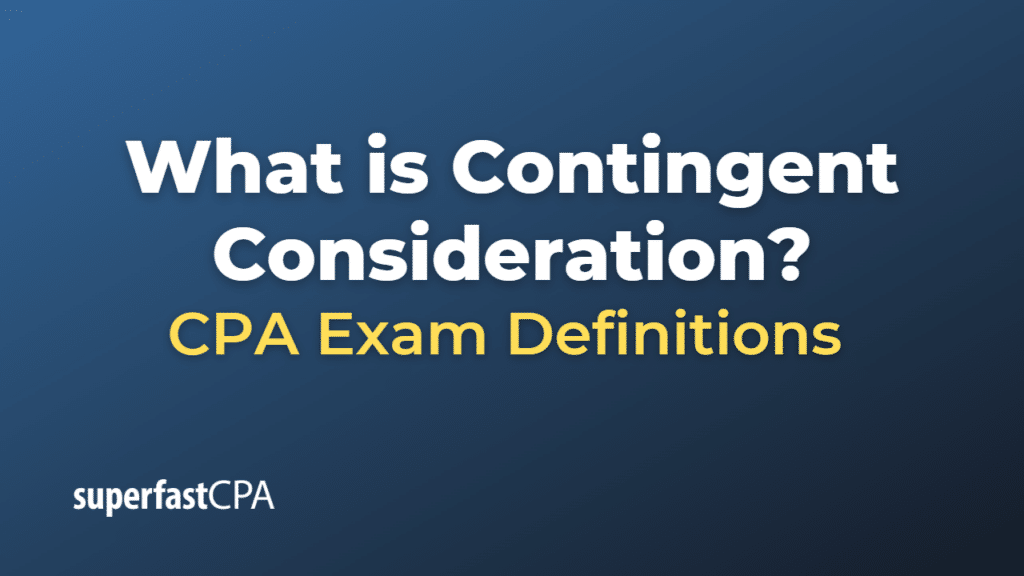Contingent Consideration
Contingent consideration is a provision often included in business acquisition or merger agreements, where the buyer agrees to pay additional amounts to the seller in the future based on the achievement of specific performance milestones or other conditions. The purpose of contingent consideration is to align the interests of the buyer and seller and ensure that the acquisition price reflects the actual value and performance of the acquired business after the transaction is completed.
Contingent consideration can take various forms, such as:
- Earnouts: An earnout is a common form of contingent consideration where the buyer agrees to pay the seller additional amounts based on the acquired business’s financial performance over a specified period. For example, the buyer might agree to pay a certain percentage of the acquired company’s revenue or profit above a predetermined threshold.
- Payments tied to specific events: Contingent consideration can also be linked to the occurrence of specific events, such as the completion of a project, the achievement of regulatory approvals, or the successful development of a product.
- Payments based on the value of assets: In some cases, contingent consideration may be tied to the value of specific assets acquired in the transaction, such as the fair value of inventory or the realization of accounts receivable.
In financial reporting, contingent consideration is recognized and measured at its fair value on the acquisition date. Subsequent changes in the fair value of contingent consideration are generally recognized in the income statement, although some changes may be recognized in equity depending on the nature of the arrangement and the applicable accounting standards.
Contingent consideration arrangements can be complex and may require significant judgment to estimate the expected future payments and determine the appropriate accounting treatment. However, they can be an effective way for buyers and sellers to share the risks and rewards associated with the future performance of the acquired business and ensure that the transaction price is fair and reflective of the business’s actual value.
Example of Contingent Consideration
Let’s consider an example of a pharmaceutical company, PharmaCo, which acquires a smaller biotechnology company, BioTech, for its innovative drug under development. The acquisition agreement includes a contingent consideration arrangement to account for the uncertainties related to the drug’s development and future performance.
The acquisition agreement specifies the following contingent consideration payments:
- Regulatory approval: PharmaCo agrees to pay BioTech’s shareholders an additional $10 million if the drug receives regulatory approval from the relevant health authorities within three years of the acquisition date.
- Sales milestones: PharmaCo also agrees to pay BioTech’s shareholders a percentage of the drug’s sales revenue after regulatory approval. The percentage is based on a tiered structure, with higher payments for higher sales levels. For example, PharmaCo might pay 5% of the sales revenue up to $50 million, 10% of sales revenue between $50 million and $100 million, and 15% of sales revenue above $100 million.
On the acquisition date, PharmaCo estimates the fair value of the contingent consideration as follows:
- Regulatory approval: PharmaCo determines that there is a 70% probability that the drug will receive regulatory approval within three years. Therefore, the estimated fair value of this contingent consideration is $7 million (70% x $10 million).
- Sales milestones: PharmaCo projects the drug’s sales revenue for the first three years after regulatory approval and estimates the probability-weighted fair value of the contingent consideration related to sales milestones as $5 million.
PharmaCo recognizes the total estimated fair value of the contingent consideration ($7 million + $5 million = $12 million) as part of the acquisition cost on the acquisition date. Subsequent changes in the fair value of the contingent consideration will be recognized in PharmaCo’s income statement or equity, depending on the applicable accounting standards and the nature of the arrangement.
This example illustrates how contingent consideration can be used in acquisition agreements to address uncertainties related to the acquired business’s future performance and ensure that the transaction price is fair and reflective of the actual value of the business.













